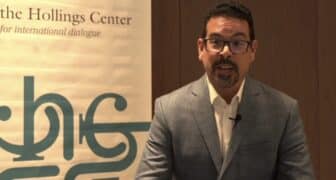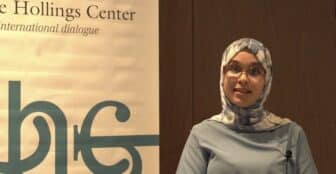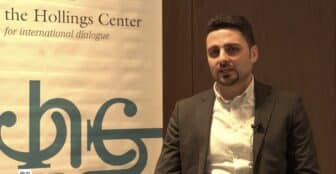Phebe Marr’s The Modern History of Iraq
(Westview Press, 2012)
Review and author interview by George Gavrilis

Writing a historical survey of any country is no easy task. This is particularly true of Iraq, where the chaos of the past ten years creates a great temptation for authors to wave away the country’s entire history as a failed political experiment mired in violent sectarianism. Marr’s Modern History of Iraq avoids this temptation and presents readers with a highly informative and sensitive account that does justice to the country’s complicated political and social history.
The book spans the British mandate period, independence, the many periods of coups and reforms, the rise of the Ba’th party as well as the cyclical ebb and flow of regional politics. It ends with the post-Saddam social and political order. While the book’s chronological organization is unsurprising and typical of broad historical surveys, it is the author’s atypical approach to Iraq that readers will find refreshing. Marr does not attribute Iraq’s troubles to British colonialism, take a fatalistic approach to sectarianism or over-emphasize the political personalities of Saddam Hussein, Muqtada al-Sadr, Nouri al-Maliki or Massoud Barzani. Nor does she linger needlessly on the well-documented mistakes of the CPA, which initially administered Iraq after the 2003 U.S. invasion.

Consider Marr’s treatment of the Mosul Revolt of 1959, which was led by the commander of the town’s garrison against the government of Abd al-Karim Qasim, who had taken power through a coup the year before. The revolt against Qasim was poorly planned and did not get anticipated support from other cities or from neighboring countries. Qasim sent airplanes to bomb the city, and the revolt was quickly snuffed out. But the bombing was only the beginning explains Marr:
Kurds looted the city and attacked the populace. The Communists and the Peace Partisans massacred some of the well-to-do Mosul families, looting their houses…The chaos that ensued provided a stark glimpse of what might be in store of a “new” Iraq if order were not restored with a firm hand. That was averted with swift, if brutal, action. Leaders of the revolt were taken into custody by Qasim, brought to trial and executed (p. 92).
Rather than explain away the Mosul events as an outgrowth of sectarianism, Marr’s account informs readers that the revolt had deep ideological roots and was as much anti-Communist as it was pro-Arab nationalist. Indeed, the left-leaning Qasim government was bent on making a series of educational, trade and agrarian reforms that required an alliance of convenience with Kurdish factions and Communists. The alliance had particularly antagonized conservative clerics, merchants and landlords who had resisted previous land reforms by shuttering their farms, locking up irrigation farms and moving to cities.
The book adeptly covers Iraq’s regional and sectarian divisions and Shi’a politics, but it is at its most vivid in discussing the politics of the Kurdish regions and parties. Many readers may be surprised to learn that the foundations of today’s Kurdish formal regionalism were not laid in the no-fly-zone days of the 1990s, but in the 1960s and 1970s, when insecure governments in Baghdad made fleeting agreements with Kurdish political and militia leaders. The first Barzani-Talabani divisions came to the fore in the 1970s, when the ruling Ba’th party offered political spoils and weapons to Kurdish leaders willing to help the party consolidate its authority. Ba’th officials in Baghdad first concluded a 1970 agreement with Barzani for “autonomy” (the first official use of the word for the region in Iraq) and, by the mid-70s, made Arbil the administrative capital. These Ba’thist measures were designed to give the government in Baghdad breathing room to shift its consolidation efforts to Shi’a areas in the south; however, Baghdad’s measures to co-opt Kurdish leadership would intensify a race across the two Kurdish factions for political and military influence that would prove difficult to tame.
Foreign policy buffs will find much of interest in the book, as Marr frequently ties in the effect of neighboring states on Iraq’s domestic politics. Particularly fascinating is Marr’s discussion of Iraq-Iran relations, which make appearances in most every chapter. Marr reminds readers that relations were thorny well before the Iran-Iraq war in the 1980s; they reached a breaking point in the late 1960s when the Ba’th party went after pro-Western, pro-Communist and pro-Iranian elements in Iraq with equal gusto. By January 1970, Baghdad had expelled the Iranian ambassador, closed consulates and deported Iranians and Iraqis of Iranian origin as a sign of its zero-tolerance of domestic interference.
This is a book that will please students of Middle East politics as much as policymakers, pundits and generalists who need a good and deep primer on Iraq. Throughout its pages, readers will encounter a series of fascinating and perhaps forgotten facts: In the 1910s, the British seconded officials from the India Office to administer Iraq; in 1958, the formation of the UAR nearly inspired Iraq, Jordan and Kuwait to unite in their own federation to which Iraq would have covered nearly 80% of the budget; in 1980, Iraqi aircraft bombed Iranian airbases and radar installations, modeling their attack on the Israeli 1967 strike on Egypt; in 1981 Saddam Hussein added “God is Great” to the Iraqi flag in an effort to deploy religion to curtail insurrection; and over 1/3 of Iraq’s labor force works for the public sector, just a notch below Saddam-era rates.
It should be said that the book ends on a reluctantly pessimistic note. Marr notes that Iraq had “settled down into a pattern representing normalcy” after the recent civil war (p. 305). At the same time, her conclusion describes an Iraq where a Maliki administration—awash in booming oil revenues—is becoming increasingly authoritarian without a viable plan to diversify the country’s economy and deal with persistent and staggering poverty.
Phebe Marr is a historian and leading authority on Iraq. She serves on the Board of Directors of the Hollings Center.
George Gavrilis recently interviewed Phebe Marr about The Modern History of Iraq and her broader work.
Gavrilis: Tell us more about your field research for the book in Iraq and any memorable stories.
Marr: I began my “field” work–so to say–in 1957 working on a thesis on the life and times of a nationalist figure who spanned the old Ottoman Empire and the formation of modern Iraq in the 1920s and 30s –a turbulent, transitional period not unlike the present one. That began my fascination with Iraq. Eventually the thesis morphed into the modern history book; the first edition came out in 1984 in the middle of the Iran-Iraq war; the second after the fall of Saddam and the third in late 2011. My real love is for the earlier historical period. While doing the research and interviewing leaders, I lived through the first “revolution” in 1958 in which Qasim replaced the monarchy. Early in 1957, to improve my spoken Arabic, an Iraqi arranged for me to stay in a village in the south near Kut–with the family of a well to do tribal-shaikh and landowner–where no one spoke English. What an experience! I was able to observe the shaikh settle disputes and virtually govern his area. I also spent hours with the women and learned about local customs and practices outside the Westernized cities. The insights I gained into family life, patterns of politics, religion and settlement of disputes has never left me–even though that feudal system has since crumbled. Under the Tribal Disputes Code, then in force, tribal areas were under the jurisdiction of the sheikh, who settled feuds through traditional arbitration and compensation (“fasl”). The practice still exists mainly in rural areas, a fact that our military officers discovered after 2003 and used to good advantage.
After 1968, I was not able to get a visa to Iraq because Saddam did not like what I was writing, but in the late 1980s, during the Iran-Iraq war, when I was working for a think tank in the National Defense University, the situation changed and I made a series of trips to Iraq traveling from one end of the country to the other. While the situation was restricted, I was able to get a good view of living conditions. In the 1990s, thanks to the hospitality of Kurdish leaders, I traveled extensively through the Kurdish areas including some formidable mountain territory. It was an exciting time for the Kurds as they were loosening their bonds with the central government. But early in 1992, the future was not so clear. I recall going into the baladiyya (municipal) office in some town and talking to the Kurdish mayor—a member of the KDP—who sat at his desk under a huge, official portrait of Saddam peering down with steely eyes. I recall thinking: Was the picture going to be coming down? Or would Saddam be back?
I have been back to Iraq several times since the 2003 transition thanks to grants from USIP for research on Iraq’s new leaders. Just as in 1957-58, despite the crush of events and difficult security circumstances, new leaders have been generous with their time. These on-the-ground experiences have made me a firm believer in “hands-on” research. They cannot substitute, of course, for documents, libraries and now the internet, but they are essential for understanding how the society functions.
Gavrilis: What aspect of Iraq’s history or politics do you think is least understood in the United States?
Marr: The least understood aspect of Iraq’s politics is its culture–its political culture– the long-standing habits and patterns of behavior that people follow and the unspoken assumptions that undergird them. For example, we attribute the authoritarian behavior of Iraq’s current government (not without some justification)—to the legacy of Saddam’s rule, but much of what we see in Iraq reminds me just as much of Nuri al-Sa’id under the Monarchy and the walis and pashas of Ottoman times.
Iraq is a patrimonial society; institutions of government and business are based on strong personal and kinship ties, which engender loyalty and trust. Patronage is a very old way of doing business. There is nothing new about it. The Ottoman Empire was based on this principle, just as was Saddam’s rule. Maliki–and Barzani–are both relying on this system behind the new constitution. It is this informal system of government–which operates in every society alongside formal structure–that is not clearly understood by most Americans. Hence we often fall back on Western models and assumptions in trying to comprehend Iraq. Institutions like parliament, political parties, trade unions and interest groups are not unfamiliar in Iraq and have a long history–stretching back at least to Ottoman times. They were institutionalized under British rule–and then collapsed under military regimes and the Ba’th. But more traditional ways of operating have persisted–although these, too, have been transformed.
To get to know and understand this informal culture–in any country–takes time and effort, and in Iraq strong personal relations. Time is the one commodity Americans do not seem to have enough of. We want efficiency and quick results, hence we often miss this cultural element. Saddam understood this. He came to power–and relied on a modern institution–a party structure with an ideology and an educated cadre, behind which he built a one-party state (in addition to coercion, of course). But behind this apparatus, he relied on his family and clan from Tikrit to hold power at the top and in all key institutions. There is a story–probably apocryphal– that when Saddam was maneuvering in the party to gain power, his uncle and father-in-law, a powerful member of a Tikrit clan, told him the party would not keep him in power but his family would. He took his advice. We probably could use a few more cultural anthropologists and historians to explore these nuances and remind us of continuities.
Gavrilis: What do you think Iraq will look like in five years?
Marr: Iraq may not look so different from what you see today, but it is difficult to predict. It will continue to be a weak state but the question is whether erosion of the social and political fabric will be so great as to create collapse. I don’t think so. Internally, the question of identity will continue to be paramount. The issue is how strong “Iraqi” nationalism will prove to be. It may be stronger than most people think, particularly compared to alternatives. The greatest division is between the Kurds and Arabs. The desire for complete independence is strong among many Kurds but not practical in that time frame; moreover, there are strong countervailing feelings among the rest of the Iraqi population. Sectarian divisions (Shi’a-Sunni) are also rising based primarily on issues of politics and political exclusion (of Sunnis). Regional conflicts, especially in Syria, are exacerbating sectarianism. Iraq’s new Shi’a leaders with a still fragile but growing hold on power feel threatened by the overthrow of the Assad government and its replacement by a Sunni dominated government, which would encourage and support its Sunni-dominated opposition. But bargaining inside Iraq between and among these groups continues and as long as it does–and some compromises are made–the new Iraq will continue, but as a highly decentralized state. As I’ve indicated, there is nothing new about this bargaining process. But for Iraq to do more than “survive,” some sort of new identity, or direction, needs to emerge that generates more common ground.
Another unknown is how the oil factor will play out. Oil production and revenues are picking up–especially in the south–and a more robust economy might ease tensions. But how the Iraqi factions deal with the oil question will be critical. If oil can generate a compromise between the Kurds and the central government on sharing the wealth, Iraq will look more stable and developed in five years. So far the outcome of this struggle is too close to call, but it may be critical in determining the degree to which Iraq—and its younger generation—focuses more on development and less on identity.
Gavrilis: What conclusions—so far—can be drawn from your project on Iraq’s textbooks?
Marr: I find the new textbooks a fascinating window on Iraq. I am mainly looking at middle and high school texts on history, civics and the social sciences, but I also find myself being drawn into reading those on literature and religion as well. I see these texts as one source for understanding what current Iraqi leaders (especially political leaders) want the next generation to learn about Iraq and the world—and how they view it themselves.
The project is still in its early stages and too early for conclusions. But several things strike me so far. The texts are in Arabic and are used throughout Iraq–except in Kurdish areas. The KRG has its own texts, as well as its own national narratives and heroes. So a separate “ethnic” identity is already putting down deep roots in Iraq. In the Arabic texts, the curriculum has been improved over Saddam’s day and appears to be much broader; courses offer a variety of subjects such as sociology, psychology, economics and geography, as well as Arab and European history. Especially in middle school, there appears to be much more emphasis on religion—Islam, but these texts are at great pains to avoid discussion of differences between the sects. Many texts emphasize the Quran and Hadiths, with explanations, including those that should shape political behavior, such as paying one‘s taxes.
One of the most striking things is what is not said, especially in history and social studies books. Texts avoid subjects which are controversial, and cannot be agreed upon, such as ethnic and sectarian differences. So far I have not seen any discussion of the Saddam era, much less the U.S. occupation–at least in the history texts. But the civics texts do cover the current constitution and its provisions; how government works; what departments exist and how people can participate in local government. I was struck by a heavy emphasis in all these texts on human rights, including equality for women, at least in theory. Most of the texts emphasize the family as the basis of society.



